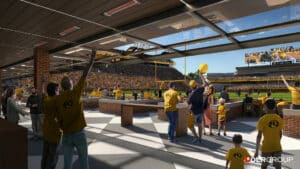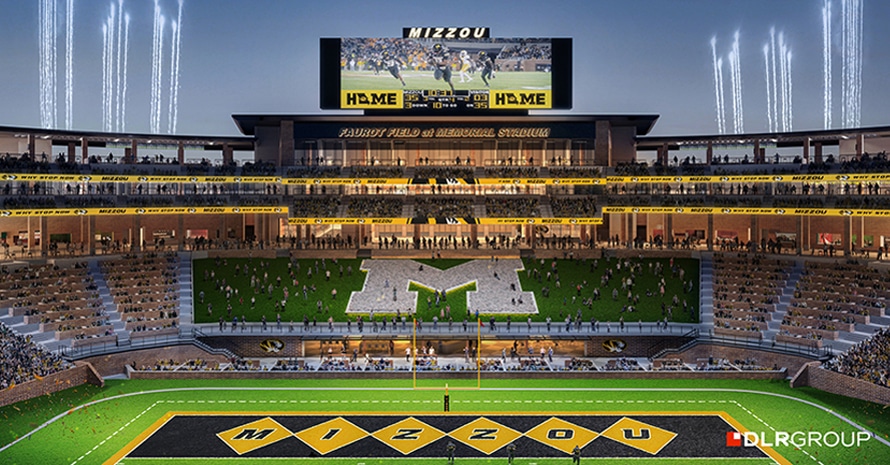TO THE NORTH: The north end zone of Memorial Stadium, which was built in 1926, will be redeveloped while preserving Rock M Hill for Missouri Tigers football games. (Courtesy DLR Group)
Open-air suites key piece of expansion
The University of Missouri plans to enclose the north end of Memorial Stadium to create more energy for football games while maintaining the historic Rock M Hill that holds reverence among alumni and students.
DLR Group was hired to design the expansion, to include a mix of open-air suites, some at field level, two indoor clubs and loge boxes framing the berm, coupled with new restrooms, concessions and a VIP entrance supporting the development.
The early estimate for the project cost is $250 million, according to a news release, but the final price tag won’t be known until the SEC school hires a construction manager, said Ryan Freeland, DLR Group’s sports design leader.
The goal is to complete the expansion by the start of the 2026 season, coinciding with the 100-year anniversary of Missouri’s first football game at Memorial Stadium.
The north end zone has been an open space for decades in Columbia, Missouri, but as the landscape of college sports changes with athletes getting paid under the Name, Image and Likeness program and the transfer portal allowing players to switch schools for the highest offer, the competition is fiercer than ever to provide first-class facilities as a lure for talent.
That’s the case at Missouri, which is a member of the ultra-competitive SEC.

TIGERS ROAR: A rendering shows the new field level suites planned for Missouri’s Memorial Stadium. (Courtesy DLR Group)
Bottom line, the project was driven by the need to create an intimidating atmosphere for opponents, Freeland said, whether it’s Alabama or Vanderbilt.
As it stands now, the north end zone, which consists of the general admission berm, lacks the energy compared with the rest of the stadium.
The expansion, covering 160,500 square feet of new construction, will effectively form a new barrier to capture and amplify sound that escapes the building under the current setup, Freeland said.
More than two-thirds of that space would be committed to premium seating with a total of 51 suites and 28 cabanas, branded as Tiger Dens.
Initial plans call for building 14 open-air suites at field level in the north end, all of which would seat 16 people.
The design extends to a 300-person indoor club, and a separate, 500-person banquet space that would serve as a new club on game days. The loge boxes book-ending the berm would seat four to six people.
The berm itself, known as Rock M Hill will remain as a general admission area, according to Freeland.
Rock M Hill dates to 1927, when Missouri freshmen created a large stone structure on the berm in the shape of a block M by using rocks left over from stadium construction. Students sit on the rocks, as well as the berm, to watch the Tigers play football. Per tradition, senior football players grab a small piece of Rock M at their final home game, according to The Athletic.
“The intent is to keep the tradition and culture around Rock M Hill,” Freeland said. “It’s not just a game day experience, but serves freshmen to seniors and transcends generations. Alumni drop their kids off at a game so they can hang out on the berm. As a freshman, you come in and paint the limestone rocks white. It’s been part of Missouri for decades.”
Missouri joins other Power 5 schools that over the past decade have redeveloped end zones with premium seating as an entry point for young alumni to purchase higher-end seating as they work their way to beachfront property — the most expensive suites and club seats situated along the sidelines.
“The school didn’t look to other stadiums as a model,” Freeland said. “They (surveyed) their fan base for what they were looking for and what was missing … more open-air experiences and the ability to be connected to the sounds and smells of the game. Being part of that energy is incredibly important and that’s where the ‘Tiger Den’ concept came about — that outdoor living room feel.”







